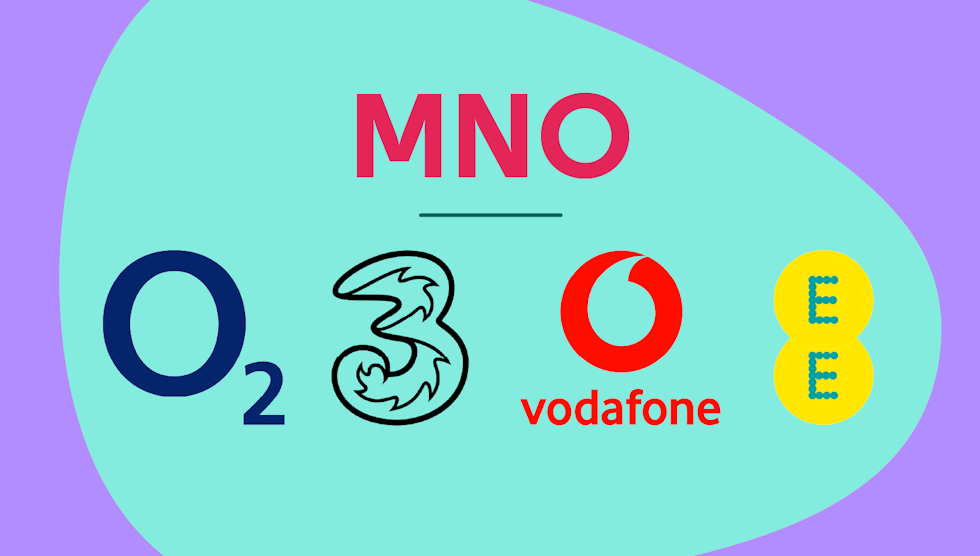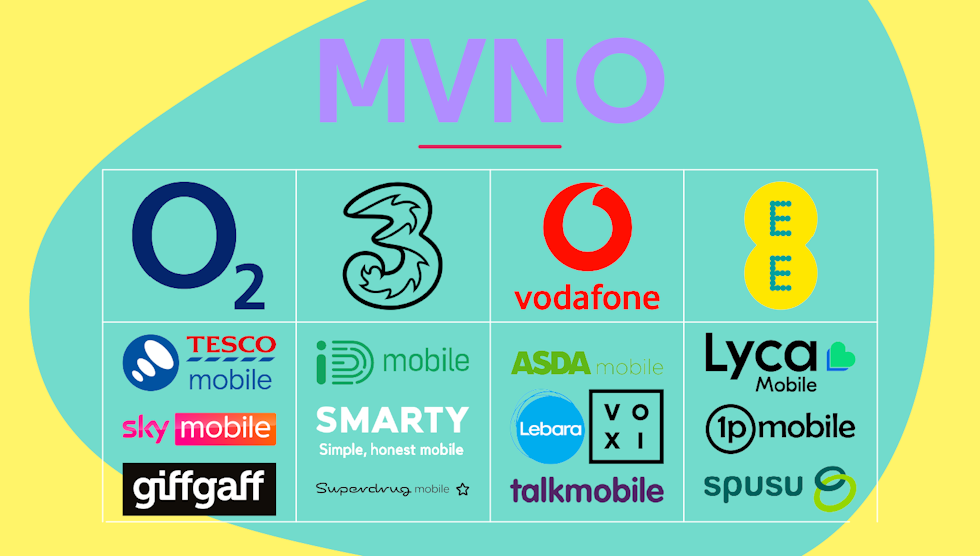When it comes to mobile phone networks in the UK, things aren’t always as straightforward as they seem.
While most people are familiar with the big names, fewer realise that many smaller providers, who typically offer cheaper or more flexible deals, actually run on the same networks behind the scenes.
We’ll break down who’s really powering your mobile signal, explore the strengths of the ‘Big Four’, and reveal which smaller providers piggyback off them to deliver value-packed alternatives.
MNO vs MVNO
First things first, you must understand the difference between an MNO and an MVNO, since these are the two terms for providers that classify them as the piggyback giver and the piggyback rider.
MNO stands for Mobile Network Operator, and these are the main network providers – your ‘Big Four’, which refers to O2, Vodafone, EE and Three. MNOs own and operate their own cellular network infrastructure (towers and base stations).
An MVNO, which stands for Mobile Virtual Network Operator, differs in that they lease network capacity from an MNO to provide their services to customers as their own brand.
In the UK, there are only the four MNOs for MVNOs to choose from, hence why they are labelled as the ‘Big Four’. As such, it is a lot easier for you to trace the network in which the smaller providers are piggybacking off of.
The ‘Big Four’ UK mobile providers (MNOs)

As mentioned, the ‘Big Four’ is made up of O2, Vodafone, EE and Three, each providing nationwide coverage for 4G and growing 5G coverage throughout.
O2
- Established: 1983
- No. of UK subscribers: ~23.2 million
- Overall coverage: 99% (3G & 4G combined)
- Strengths: Inclusive perks (e.g. O2 Priority), solid 4G reach
- Weaknesses: Slower data speeds than EE/Vodafone
O2 is a major UK mobile provider known for flexible plans and strong nationwide coverage. Customers get access to O2 Priority, offering early ticket access, discounts, and freebies. Many plans include EU roaming at no extra cost, making it great for travellers.
As part of Virgin Media O2, there are also bundle deals with Virgin Media broadband plus boosts such as double data, known as ‘Volt’ benefits, for added value.
Vodafone
- Established: 1984
- No. of UK subscribers: ~18.3 million
- Overall coverage: 99% 4G
- Strengths: Roaming benefits, international coverage, data rollover
- Weaknesses: Network speed inconsistencies
Vodafone offers solid UK coverage with strong international roaming options, including inclusive EU roaming on select plans. Its VeryMe Rewards app gives customers access to weekly treats, discounts, and giveaways.
Vodafone also stands out for Global Roaming Plus, which includes roaming in destinations beyond Europe. With a mix of flexible plans and family options, it’s a strong choice for frequent travellers and multi-line households.
Three
- Established: 2003
- No. of subscribers: ~10.9 million
- Overall coverage: 99% 4G, over 60% 5G
- Strengths: Large 5G bandwidth, great for data-hungry users
- Weaknesses: Spotty rural coverage
Three is a data-focused network offering generous allowances and some of the most competitive pricing among the Big Four. It boasts a large chunk of the UK’s 5G spectrum, making it great for heavy streamers and gamers.
Features like Go Roam let customers use their plans in over 70 destinations worldwide. While rural coverage can lag behind rivals, Three is ideal for value seekers who prioritise data and travel flexibility.
EE
- Established: 2010
- No. of subscribers: 21.2 million
- Overall coverage: 86% of UK landmass
- Strengths: Fastest 5G speeds, wide coverage
- Weaknesses: Generally higher prices
EE is known for having the fastest and widest 4G and 5G coverage in the UK, making it ideal for speed-focused users. It offers Smart Benefits on select plans, like access to Apple Music, Netflix, or roaming passes.
EE customers also get perks like Wi-Fi coverage on the London Underground and in over 150,000 BT Wi-Fi hotspots. Though often priced higher, EE delivers top-tier performance and premium extras for those who want the best network experience.
Vodafone and Three merger – MOCN
In May of this year, it was announced that Vodafone and Three had entered into a merger with one another, becoming the nation’s largest mobile operator.
As of Mid-June, customers of Vodafone and Three will be able to roam using both networks, with their phone connecting to the nearest and strongest network available. This is what’s known as an MOCN, or a Multi-Operator Core Network.
UK MVNOs by network

There are plenty of other options of providers for you to choose from outside the Big Four. You may have seen ads for the likes of GiffGaff, VOXI and Tesco Mobile, all of which have great offerings for customers and their own perks as standard.
But while there’s a range of providers to choose from, you’ll probably want to know which network they are on so that you can go for the one that’ll give you the best connection – that is, if you don’t want to choose one of the Big Four.
Powered by O2
- Tesco Mobile
- Sky Mobile
- giffgaff
Powered by Vodafone
- VOXI
- Talkmobile
- Lebara
- Asda mobile
Powered by EE
- Lyca Mobile
- 1pMobile
- Spusu
Powered by Three
- iD Mobile
- SMARTY
- Superdrug Mobile
Key considerations when choosing a provider
When choosing a mobile network, coverage should be your top priority. Not all networks perform equally in every location, so it’s important to check how each provider fares in your area using tools like the Ofcom Coverage Checker.
If you live in a rural or coastal region, providers like EE or O2 may offer better signal strength. Urban users might have more flexibility, but even then, the quality of indoor signal, 5G availability, and call reliability can vary. A network that looks cheaper on paper may cost more in frustration if your coverage is poor.
Beyond coverage, consider your usage habits and lifestyle. Heavy streamers or remote workers may need fast, high-data plans, making networks like Three (known for generous data at low prices) an attractive option.
Frequent travellers should look for strong roaming policies – Vodafone and O2 stand out here. Other features like family plan discounts, contract flexibility, bundled perks (e.g. entertainment or broadband), and customer service ratings can also influence your decision.
Think not just about cost, but about value: the network that meets your specific needs most reliably, at a fair price, will always be the right choice.


